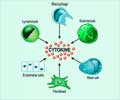
"By first applying novel methodologies to study the amoeba Dictyostelium, an experimental system often used by cell biologists, we were able to discover the basic mechanisms that control amoeboid movement, which we then applied to understanding white blood cells."
The team used new analytical tools to measure, with a high degree of accuracy and resolution, the forces the cells exert to move forward. The novel methodology, which they have been refining during the last several years supported by grants from the National Institutes of Health (R01-GM084227 and R01-GM037830), is called Fourier Traction Force Microscopy. Before their study, scientists thought white blood cells did not move in a highly coordinated manner.
Furthermore, their work discovered that cells move by not only extending themselves at their front and contracting their backs, but also by squeezing inwardly along their lateral sides pushing the front of the cell forward. These findings establish a new paradigm as to how cell move. The research team is currently extending their techniques, which they have used to study leukocytes and other types of amoeboid cells, to investigate the mechanics of cancer cell migration and invasion.
Source-Eurekalert













